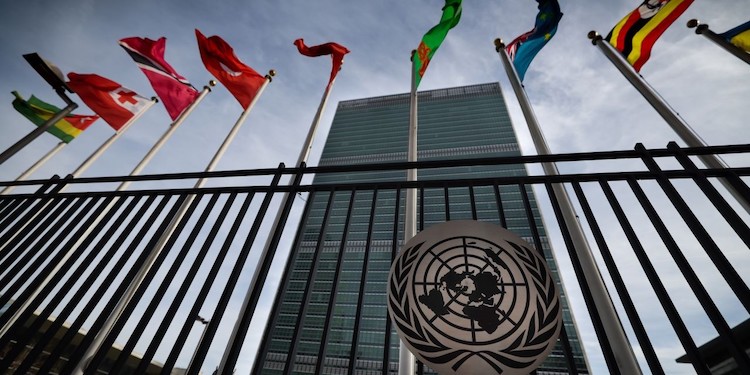By Jordan Ryan*
This article was issued by the Toda Peace Institute and is being republished with their permission.
ATLANTA, Georgia, USA. (IDN) — Today’s world is beset by complex and interlinked global challenges—from the existential threat of climate change to rising geopolitical tensions reminiscent of the Cold War. Devastating conflicts rage internally in nations like Syria and Yemen, while hostility and rivalry between global powers such as the US, China, and Russia frequently leads to paralysis on the international stage. Meanwhile, truly global issues like pandemics, mass migration, social polarisation, and economic crises continue to profoundly threaten human security worldwide.
The post-WWII architecture centred around the UN Security Council is often inadequate to respond effectively to this dizzying array of modern, interconnected threats. Power dynamics and gridlock amongst the P5 frequently block Council action, undermining its legitimacy and limiting its efficacy. More inclusive, representative global leadership is essential at this perilous moment in history.
Agenda for Peace
Within this context, the core theme of UN Secretary-General Antonio Guterres’ proposed New Agenda for Peace is that by embracing targeted reforms and injecting renewed commitment to proactive multilateral action, the UN can evolve beyond dated modalities and realise a more versatile, resilient 21st century architecture capable of responding to current challenges. As Member States consider the Secretary-General’s proposal, the following elements should be addressed.
Prevention and mediation capacities need urgent scaling up to intervene before conflicts erupt into violence. The UN’s lag in preventative action is evident in the ongoing war in Ukraine, where robust early mediation was lacking. Investing urgently in prevention is vital to avoid such tragedies. Member states should increase funding and personnel dedicated to prevention, while exploring how defense resources could be strategically redirected to supplement these peaceful means. Appointing empowered senior envoys supported by expert mediation teams is prudent, as is ensuring that Resident Coordinators on the ground have sufficient resources to lead local coordination efforts to promote development and ensure peace is sustained.
Swift collective action
Streamlining decision-making processes is critical when swift collective action is needed. The P5 should voluntarily refrain from exercising veto powers on vital humanitarian issues. Progress on equitable Council reform, including expanding the permanent membership, remains essential for legitimacy and effectiveness moving forward. Incentives for compromise and consensus can help overcome impasses when divisions arise.
But while pivoting toward prevention is wise, concrete steps for resolving ongoing conflicts are still indispensable. Creative diplomacy and bridging divides amongst Council members will remain essential in addressing the most severe and intractable crises. Investing more in unarmed civilian peacekeeping could supplement thinly stretched UN peace operations.
Updating the UN’s antiquated multilateral architecture will be an iterative process requiring both institutional reforms and operational agility. Embracing diversity in mediation teams would inject new perspectives and skills into prevention efforts. Harnessing technology like early warning systems could boost efficacy on the ground. Fostering partnerships with regional organizations, civil society networks, and the private sector could multiply capacity.
Conclusion
Three decades ago, Boutros Boutros-Ghali introduced the first Agenda for Peace in 1992 amid seismic geopolitical shifts in the post-Cold War landscape. Today, global dynamics have been transformed anew. Inter-state conflicts have resurged, and the world has become increasingly multipolar, seriously undermining how and whether the UN can respond to crises.
The New Agenda’s success rests on transitioning from rigid, traditional modalities to more adaptive, inclusive peace architecture. Doing so requires sustained commitment to multilateralism and willingness to harness new ideas and partners. With pragmatic reforms, operational agility, and collective action, the UN can better deliver on its founding vision and address complex 21st century threats. Although the road ahead is fraught, progress towards a new architecture for peace is within reach if member states are willing to act courageously and collaboratively.
Related articles:
UN proves UN cannot single-handedly usher in a nuclear weapons-free world (3-minute read)
Policy Brief No.139: Nuclear Disarmament and UN Reforms (15-minute read)
*Jordan Ryan is a Senior Consultant to the Folke Bernadotte Academy and former Vice President for Peace at The Carter Center. He recently completed an assignment as the lead author of the UN integration review for the Executive Office of the Secretary-General. Mr. Ryan served as UN Assistant Secretary-General and UNDP Assistant Administrator from 2009-2014. He was Deputy Special Representative in Liberia and UN Resident Coordinator in Vietnam. Mr. Ryan has graduate degrees from Columbia University and George Washington University, and received his B.A. from Yale University. He was a fellow at Harvard’s Kennedy School. [IDN-InDepthNews]
Image: Viktor_IS/shutterstock.com
Original link: https://toda.org/global-outlook/2023/realising-the-uns-vision-steps-toward-a-new-architecture-for-peace.html
IDN is the flagship agency of the Non-profit International Press Syndicate.

